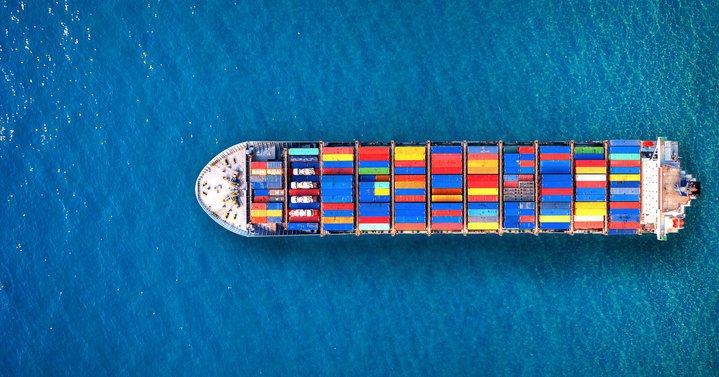
Ocean shipping routes are the lifeblood of the global supply chain, as an estimated 90% of traded goods are carried across oceans. Understanding shipping route patterns and how they impact container capacity and ocean freight rates is essential for procurement and logistics planning. This article provides information on the world’s busiest shipping routes and tips to help shippers and importers navigate the current ocean freight market.
What are Shipping Routes & Trade Lanes?
Similar to roads on land, shipping routes or sea routes refer to the navigable lines of travel that sea vessels follow. Shipping routes connect major ports and are generally classified by the body of water they cross (TransPacific) or the channel that connects two bodies of water (Suez Canal, Panama Canal, Strait of Malacca). Shipping route data provides insight into ocean traffic volumes, but does not necessarily indicate the direction of traffic.
Trade lanes are more specific than ocean routes and provide information on the direction of trade between two ports, countries, or regions. Trade lane data is extremely important for shippers and importers, as lane volumes and demand directly impact ocean freight rates. Having an understanding of general trade patterns and the busiest shipping routes can help shippers navigate and negotiate in the volatile freight market. Trade lane data can also provide useful insight into new procurement strategies, as importers look to source materials from lower-volume regions in order to save on freight costs.
What are the World’s Busiest Shipping Routes & Lanes by Volume?
Considering the impact that trade lane volumes have on freight rates, we are going to explore the busiest shipping routes in the world, and discuss specific trade lanes and ports that impact those routes.
Intra-Asia
Diversification in export manufacturing in Asia has caused a substantial shift in shipping routes within the region. As the U.S. and Europe moved production from China to other Asian nations to avoid tariffs or seek lower labor costs, shipping within Asia increased. This is because the main trade lanes to Europe and North America are serviced by ultra-large container ships, many of which cannot access smaller ports in places like Cambodia and the Philippines. So finished products from those countries are often routed through larger, busier ports in China or Vietnam before sailing to their final destinations.
This shift made intra-Asia the busiest shipping route in the world. It is estimated that 43.5 million TEUs will move annually on this route between 2022 and 2025, constituting a quarter of the world’s sea trade. Much of this freight will move through the Strait of Malacca, which connects three of Asia’s largest economies: India, China, and Japan to each other, as well as hubs in Thailand, Indonesia, Singapore, Malaysia, Vietnam, Taiwan, and South Korea.
This is important for importers to recognize when sourcing and purchasing goods from Asia. Shipping from smaller ports may not provide insulation from congestion and delays, as goods will likely be transloaded to a larger ship in a major port before making the voyage overseas. Consulting with a knowledgeable ocean freight partner to discuss routing options and transit times can guide decision-making in sourcing and logistics.
Asia - North America
Fueled by the injection of economic stimulus payments in April 2020, the U.S. is spending an unparalleled amount on consumer goods, many of which are produced inexpensively in Asia. This increased demand for Asian exports created a massive container imbalance, putting immense pressure on the global supply chain. It has also created significant congestion at U.S. ports, which lack the infrastructure to manage the sudden influx of containers.
The jump in demand for Asian exports made the trans-Pacific one of the busiest shipping lanes in the world, and also the most expensive. As freight industry professionals and government agencies attempt to develop solutions for backlogged ports and inland capacity, U.S. importers face the reality that freight rates from Asia will likely remain high so long as demand does. At current levels it is estimated that 21.8 million TEUs will move annually on Asia - North America lanes, an increase of nearly 20 percent over 2019 volumes. So while rates should stabilize over time, it is almost certain they will not drop back to pre-pandemic levels, and will continue to impact economic inflation across North America.
While any route from Asia to North America is among the world's busiest shipping lanes, routes out of major ports like Shanghai, Ningbo, or Shenzhen into other major ports like Los Angeles/Long Beach and New York City are by far the busiest. High demand into these U.S. ports can disrupt service to smaller ports along the route, particularly those in the Gulf of Mexico, which can easily be bypassed on the way to the East Coast. Importers who rely on service into Houston, New Orleans, or Mobile may need to consider drayage options out of other major hubs to avoid supply chain disruption on urgent shipments.
Asia - Europe
Asia ships approximately 14.3 million TEUs to Europe, making it another of the world's busiest shipping lanes. This route relies on the Suez Canal to connect the Indian and Atlantic Oceans via the Red Sea. The canal is so narrow that it cannot manage two-way traffic, sometimes resulting in wait-times of a week or more for passage. The limitations of the Suez Canal were brought to light in 2021, when the Ever Given ship became lodged for 6 days, delaying more than 400 other ships and interrupting billions of dollars in international trade.
Similar to North America, Asian trade with Europe has dramatically impacted the container imbalance, with only 7.5 million TEUs shipping from Europe back to Asia. In an attempt to rebalance containers and return them to Asia where they can generate revenue, carriers are omitting ports from service and scheduling blank sailings from Europe, resulting in further rate volatility in both imports and exports. Again, just as in the U.S., service to large European ports is prioritized, meaning Rotterdam, Antwerp, and Hamburg are likely to stay in rotation for consistent service.
North America - Asia
Despite the large trade imbalance between the regions, North America to Asia is still one of the world's busiest shipping routes, with an estimated 8.4 million TEUs shipping annually through 2025. Top exports from the U.S. to Asia include airplanes and other aircraft, soy beans, and automobiles, while Canada ships coal, iron ore, and wood pulp, and Mexico exports primarily technical apparatus and plastics.
Pacific Ocean ports are most often used for North American exports to China. This includes Los Angeles, Long Beach, Seattle/Tacoma in the U.S., as well as Vancouver in Canada, and Manzanillo in Mexico. Houston is an outlier in this category, as it is a major port for crude oil and chemical exports to Asia.
Other Notable Trade Routes
- Asia - Latin America: another major trans-Pacific route, moving 4.9 million TEUs of consumer goods per year into ports primarily in Brazil, Peru, and Argentina.
- Europe - North America: 4.3 million TEUs annually, major exports include aircraft, mineral fuel, optical and medical instruments, and pharmaceuticals.
- Latin America - North America: currently around 3 million TEUs annually, exports from Latin America are commodities like foods, plant products, fuel, and raw materials. There is potential for significant growth for exports out of this region as North American companies seek out near-shoring options to mitigate volatile freight costs from Asia.
- Latin America - Asia: an estimated 2.1 million TEUs are moving annually on this route, and is likely to continue increasing. Chile, Peru, and Brazil are major exporters of copper, iron ore, soybeans and beef, which are high-demand imports for China and other Asian nations.
Navigating Shipping Routes with a Freight Marketplace
Digital freight marketplaces, like FreightMango, are designed to simplify the ocean container shipping process by giving shippers and importers instant access to freight rates and real-time capacity on the world's busiest shipping lanes. Shippers have the opportunity to compare rates on various lanes and achieve instant cost-savings on freight. FreightMango’s team of experienced ocean freight operators are available to offer insight into routing and transit before booking, as well as digitized support throughout the shipping process - ensuring a seamless transaction from start to finish. Contact FreightMango today to learn more and get a demo of their simple, online freight marketplace.





 Get instant quote
and compare offers in real time
Get instant quote
and compare offers in real time